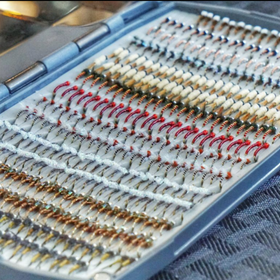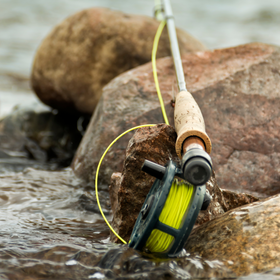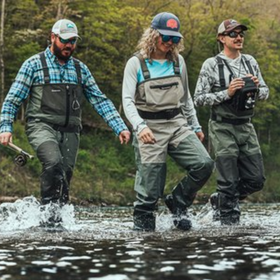The picturesque boulder-filled Cheesman Canyon portion of the South Platte River is considered by many one of the most pristine fisheries in the world. This area, often times simply referred to, as “the Canyon” is an experience you’ll never forget. It’s the perfect scenario, magnificent beauty in combination with great fly fishing. The South Platte River carves its way through a granite canyon lined with ponderosa pines, willows, fallen tree trunks, and various other assorted ground foliages. Boulders as big as Volkswagens Beetles create structure for the super-selective trout residing in the river. Mule Deer, Black Bear, Raccoons, Mountain Lyons, and Bald Eagles all add to the experience. Anglers can expect to catch mostly large rainbows supplemented with a few nice brown trout. The aforementioned “canyon” is as technical as they get, and if you can catch trout here, you can catch them anywhere in the world. This three-mile section is primarily a nymphing fishery requiring tiny midge and mayfly imitations with fine 5 and 6X tippets. Ideal flows for Cheesman Canyon are between 250 and 400 cfs. The regulations are flies and lures only. All fish must be returned to the water immediately. Cheesman Canyon is one of the best tailwaters in the country. There's a common belief among "canyon regulars" that if you can catch fish on the South Platte River, you can fool fish anywhere in the world. There's no substitution for good technique in Cheesman Canyon.
Updated 10/18/25
Flows have not changed much at all since our last report. We're still seeing good midge and baetis hatches throughout the day. Water is low and clear in the canyon, and that means school is in session and fishing can be a challenge.
That said, this is a fun time of year that offers good opportunity to catch fish nymphing, dry fly fishing, and/or on streamers. Eggs, leeches and small baetis are go-to for nymphing rigs. Small Parachute Adams or Sparkle Duns are great immitations if you see trout eating dries. For streamers, we like Chicago Overcoats or Wooly Buggers right now.
Updated 9/26/25
Fall is here! Flows from the dam have ratcheted down to 145 cfs. The fishing here will only get more technical as flows drop, but we've seen good midge and baetis hatches lately.
Now is the time of year we start switching our nymphing rigs over to egg and midge/baetis combos. That said, you might get lucky enough to catch some fish on dries during the baetis hatch.
Updated 9/12/25
Flows coming out of Cheesman bumped back up to 260 cfs since our last update.
We've been seeing hatches of midges, baetis and PMDs here. Given the flow bump, try scuds, worms or stoneflies as your lede pattern, with smaller "match the hatch" tailwater flies dropped off.
The famed tailwater below Cheesman Dam is the crown-jewel of the South Platte River. The stellar views here match the quality of fish you'll find in the boulder-strewn riverbed.
During summer in the canyon you'll find a variety of bugs hatching, but stealth is always key when fishing here.
Here are some effective fly patterns to consider for summer fishing in this area:
Terrestrials: Chubby Chernobyls, Stimulators, Amy's Aunts are all classic "big" dry fly patterns that can be fished as attractors or to imitate hoppers or stoneflies.
Caddis: One of the main summertime staples for trout. The classic Elk Hair Caddis is a tough pattern to beat for imitating adult dries, while Barr's Graphic Caddis or Sparkle Pupa for emergers work great. For larva, Electric Caddis or a Buckskin is the way to go.
Pale Morning Duns: This hatch can bring some of summer's best dry fly fishing! An Adams or Sparkle Dun in 16 or 18 will effectively imitate an adult PMD. A Pheasant Tail or Juju PMD are great to imitate the bug's emergence.
Blue-Winged Olives (BWOs): BWOs hatch from Spring into early Summer. For dries, carry High-Vis Baetis and Parachute Adams in sizes #18 to #22. For nymph, pheasant tails, Juju Baetis, RS2s, and foam wing emergers in the same sizes.
Midges: Midges are prevalent year-round and still a key staple during summer, especially in the mornings. Use patterns like Blood Midges, Black Beauties, and Pale Olive Larvas in sizes ranging from #22 to #24.
As always, observe the water conditions, insect activity, and the behavior of the fish to determine the most effective patterns and presentations. Adjust your techniques throughout the day as conditions change.
The shop staff and guides at The Blue Quill Angler are very familiar with the South Platte River and can provide specific insights into recent hatches, successful patterns, and techniques tailored for summer fishing in the area. They often have firsthand knowledge that can greatly enhance your fishing experience.








